Key Macro Issues Impacting the Travel and Leisure Sector
VerifiedAdded on 2020/10/22
|10
|2697
|317
Report
AI Summary
This report delves into the key macro issues within the business environment that significantly impact the travel and leisure sector. It identifies and describes crucial factors such as political instability, economic fluctuations, social trends, technological advancements, legal regulations, and environmental concerns, utilizing the PESTLE framework for analysis. The report further explores the potential micro-level impacts of these macro issues, specifically focusing on political and environmental factors, and provides real-world examples from the hotel sub-sector. Additionally, the report addresses the challenges encountered during the research and writing process, such as a lack of awareness and research skills, and suggests practical strategies for overcoming these obstacles, including seeking diverse perspectives and utilizing available resources. The analysis underscores the direct influence of macro factors on the travel and leisure sector and highlights the importance of understanding these dynamics for effective business strategies.
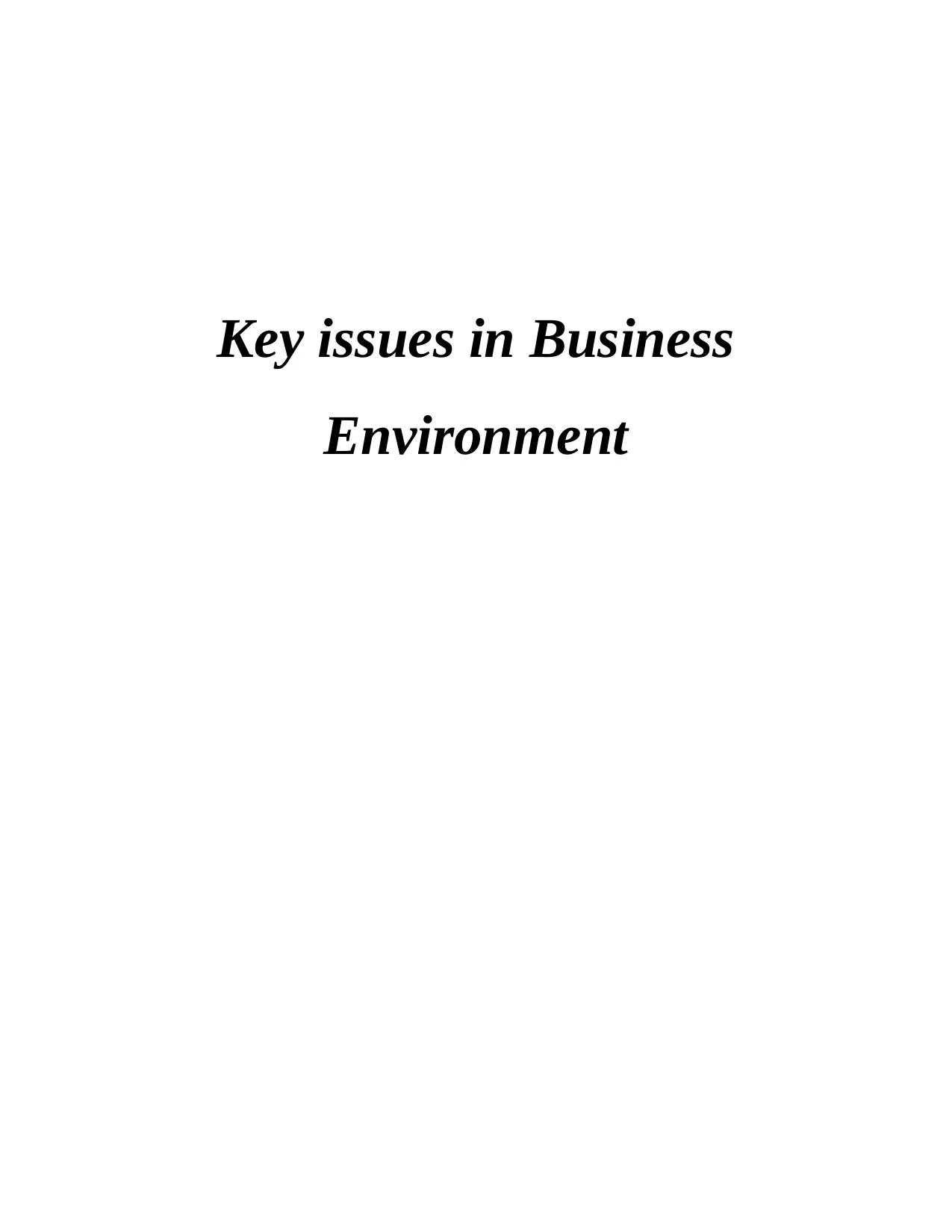
Key issues in Business
Environment
Environment
Paraphrase This Document
Need a fresh take? Get an instant paraphrase of this document with our AI Paraphraser
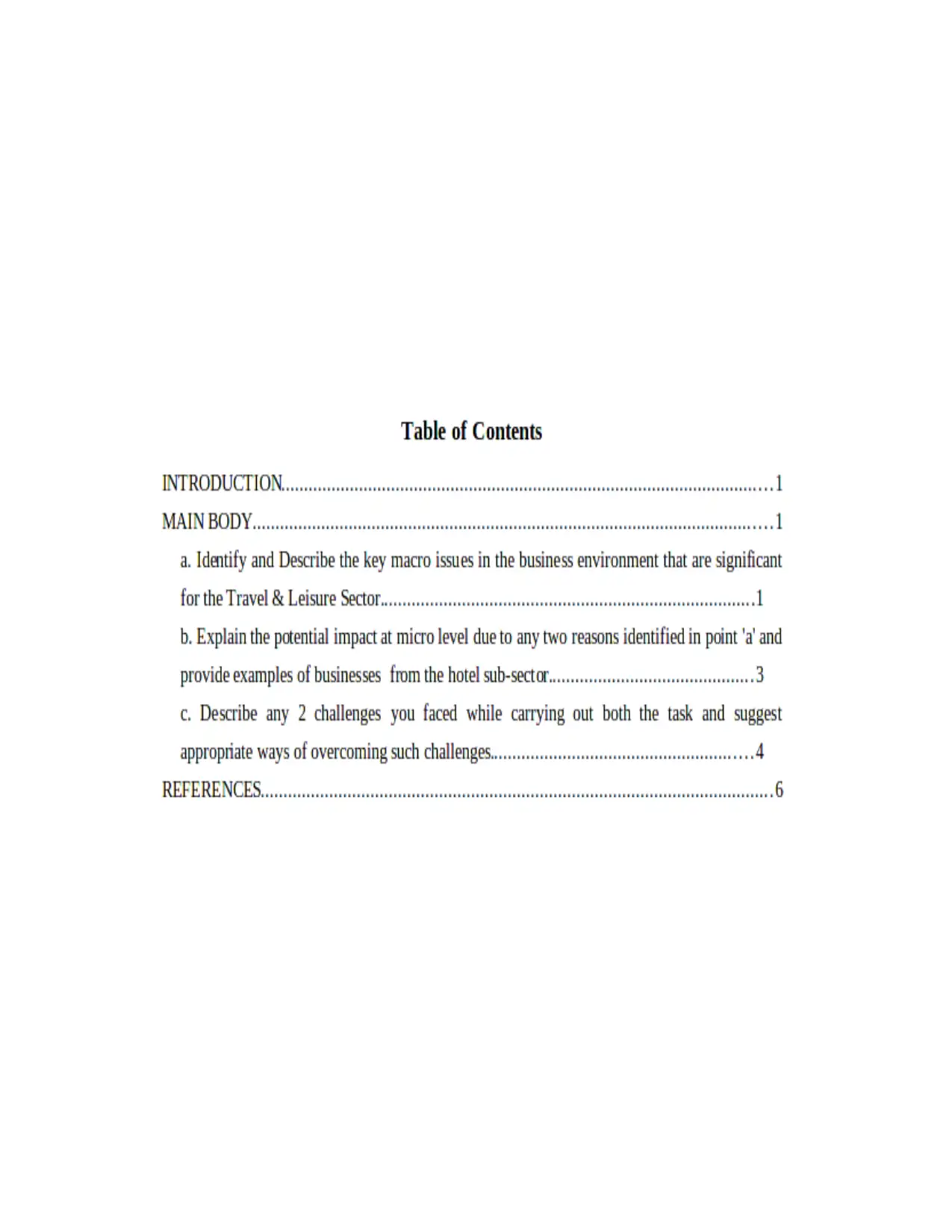

⊘ This is a preview!⊘
Do you want full access?
Subscribe today to unlock all pages.

Trusted by 1+ million students worldwide
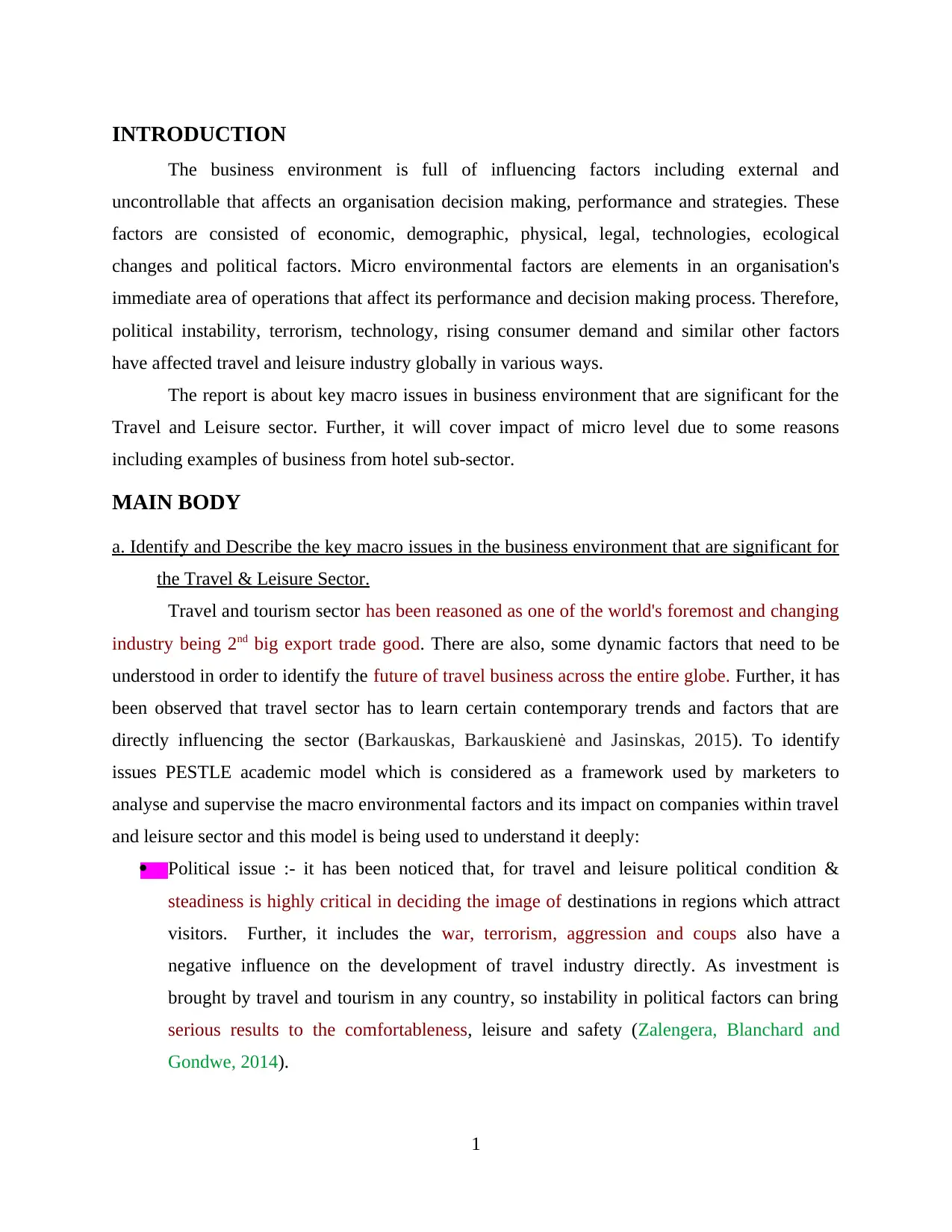
INTRODUCTION
The business environment is full of influencing factors including external and
uncontrollable that affects an organisation decision making, performance and strategies. These
factors are consisted of economic, demographic, physical, legal, technologies, ecological
changes and political factors. Micro environmental factors are elements in an organisation's
immediate area of operations that affect its performance and decision making process. Therefore,
political instability, terrorism, technology, rising consumer demand and similar other factors
have affected travel and leisure industry globally in various ways.
The report is about key macro issues in business environment that are significant for the
Travel and Leisure sector. Further, it will cover impact of micro level due to some reasons
including examples of business from hotel sub-sector.
MAIN BODY
a. Identify and Describe the key macro issues in the business environment that are significant for
the Travel & Leisure Sector.
Travel and tourism sector has been reasoned as one of the world's foremost and changing
industry being 2nd big export trade good. There are also, some dynamic factors that need to be
understood in order to identify the future of travel business across the entire globe. Further, it has
been observed that travel sector has to learn certain contemporary trends and factors that are
directly influencing the sector (Barkauskas, Barkauskienė and Jasinskas, 2015). To identify
issues PESTLE academic model which is considered as a framework used by marketers to
analyse and supervise the macro environmental factors and its impact on companies within travel
and leisure sector and this model is being used to understand it deeply:
Political issue :- it has been noticed that, for travel and leisure political condition &
steadiness is highly critical in deciding the image of destinations in regions which attract
visitors. Further, it includes the war, terrorism, aggression and coups also have a
negative influence on the development of travel industry directly. As investment is
brought by travel and tourism in any country, so instability in political factors can bring
serious results to the comfortableness, leisure and safety (Zalengera, Blanchard and
Gondwe, 2014).
1
The business environment is full of influencing factors including external and
uncontrollable that affects an organisation decision making, performance and strategies. These
factors are consisted of economic, demographic, physical, legal, technologies, ecological
changes and political factors. Micro environmental factors are elements in an organisation's
immediate area of operations that affect its performance and decision making process. Therefore,
political instability, terrorism, technology, rising consumer demand and similar other factors
have affected travel and leisure industry globally in various ways.
The report is about key macro issues in business environment that are significant for the
Travel and Leisure sector. Further, it will cover impact of micro level due to some reasons
including examples of business from hotel sub-sector.
MAIN BODY
a. Identify and Describe the key macro issues in the business environment that are significant for
the Travel & Leisure Sector.
Travel and tourism sector has been reasoned as one of the world's foremost and changing
industry being 2nd big export trade good. There are also, some dynamic factors that need to be
understood in order to identify the future of travel business across the entire globe. Further, it has
been observed that travel sector has to learn certain contemporary trends and factors that are
directly influencing the sector (Barkauskas, Barkauskienė and Jasinskas, 2015). To identify
issues PESTLE academic model which is considered as a framework used by marketers to
analyse and supervise the macro environmental factors and its impact on companies within travel
and leisure sector and this model is being used to understand it deeply:
Political issue :- it has been noticed that, for travel and leisure political condition &
steadiness is highly critical in deciding the image of destinations in regions which attract
visitors. Further, it includes the war, terrorism, aggression and coups also have a
negative influence on the development of travel industry directly. As investment is
brought by travel and tourism in any country, so instability in political factors can bring
serious results to the comfortableness, leisure and safety (Zalengera, Blanchard and
Gondwe, 2014).
1
Paraphrase This Document
Need a fresh take? Get an instant paraphrase of this document with our AI Paraphraser
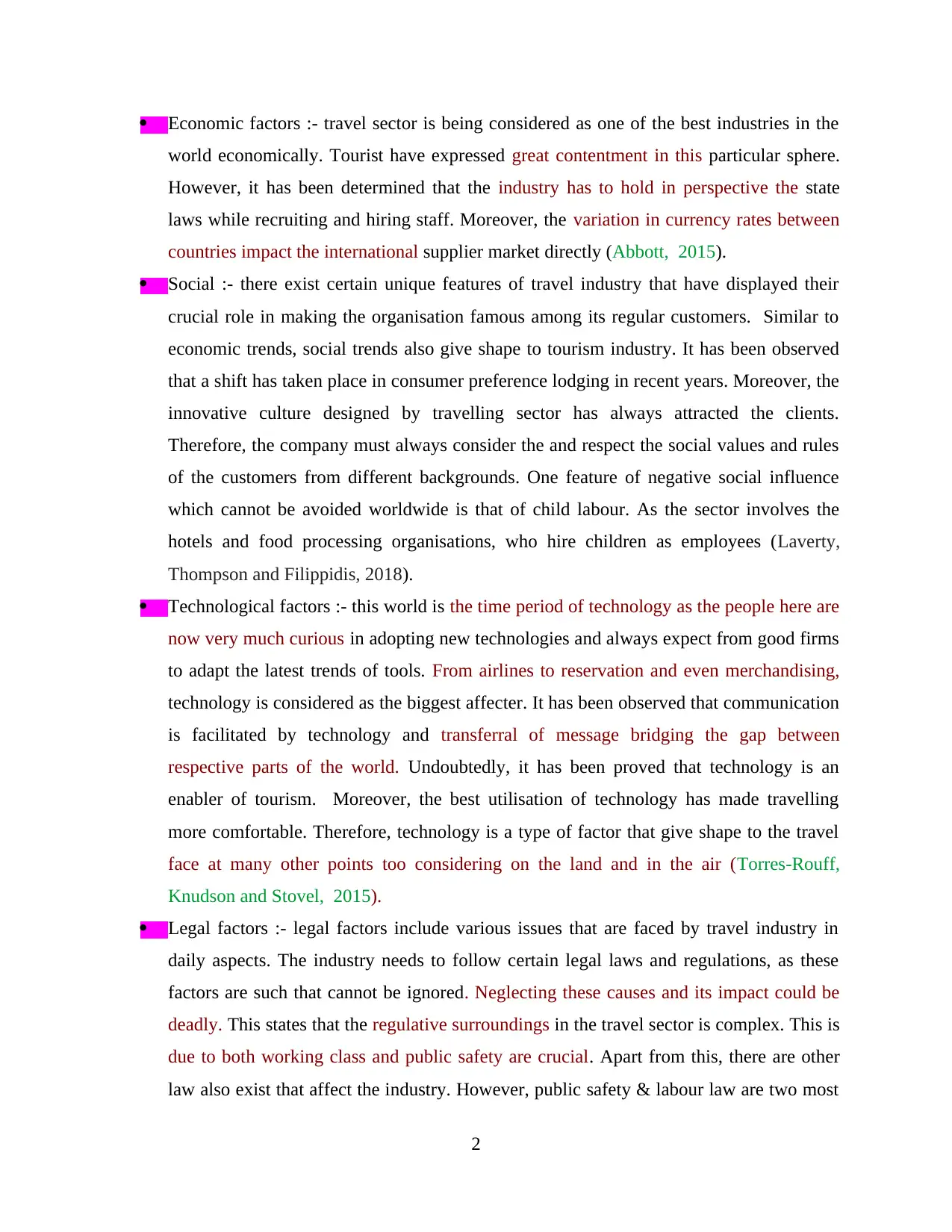
Economic factors :- travel sector is being considered as one of the best industries in the
world economically. Tourist have expressed great contentment in this particular sphere.
However, it has been determined that the industry has to hold in perspective the state
laws while recruiting and hiring staff. Moreover, the variation in currency rates between
countries impact the international supplier market directly (Abbott, 2015).
Social :- there exist certain unique features of travel industry that have displayed their
crucial role in making the organisation famous among its regular customers. Similar to
economic trends, social trends also give shape to tourism industry. It has been observed
that a shift has taken place in consumer preference lodging in recent years. Moreover, the
innovative culture designed by travelling sector has always attracted the clients.
Therefore, the company must always consider the and respect the social values and rules
of the customers from different backgrounds. One feature of negative social influence
which cannot be avoided worldwide is that of child labour. As the sector involves the
hotels and food processing organisations, who hire children as employees (Laverty,
Thompson and Filippidis, 2018).
Technological factors :- this world is the time period of technology as the people here are
now very much curious in adopting new technologies and always expect from good firms
to adapt the latest trends of tools. From airlines to reservation and even merchandising,
technology is considered as the biggest affecter. It has been observed that communication
is facilitated by technology and transferral of message bridging the gap between
respective parts of the world. Undoubtedly, it has been proved that technology is an
enabler of tourism. Moreover, the best utilisation of technology has made travelling
more comfortable. Therefore, technology is a type of factor that give shape to the travel
face at many other points too considering on the land and in the air (Torres‐Rouff,
Knudson and Stovel, 2015).
Legal factors :- legal factors include various issues that are faced by travel industry in
daily aspects. The industry needs to follow certain legal laws and regulations, as these
factors are such that cannot be ignored. Neglecting these causes and its impact could be
deadly. This states that the regulative surroundings in the travel sector is complex. This is
due to both working class and public safety are crucial. Apart from this, there are other
law also exist that affect the industry. However, public safety & labour law are two most
2
world economically. Tourist have expressed great contentment in this particular sphere.
However, it has been determined that the industry has to hold in perspective the state
laws while recruiting and hiring staff. Moreover, the variation in currency rates between
countries impact the international supplier market directly (Abbott, 2015).
Social :- there exist certain unique features of travel industry that have displayed their
crucial role in making the organisation famous among its regular customers. Similar to
economic trends, social trends also give shape to tourism industry. It has been observed
that a shift has taken place in consumer preference lodging in recent years. Moreover, the
innovative culture designed by travelling sector has always attracted the clients.
Therefore, the company must always consider the and respect the social values and rules
of the customers from different backgrounds. One feature of negative social influence
which cannot be avoided worldwide is that of child labour. As the sector involves the
hotels and food processing organisations, who hire children as employees (Laverty,
Thompson and Filippidis, 2018).
Technological factors :- this world is the time period of technology as the people here are
now very much curious in adopting new technologies and always expect from good firms
to adapt the latest trends of tools. From airlines to reservation and even merchandising,
technology is considered as the biggest affecter. It has been observed that communication
is facilitated by technology and transferral of message bridging the gap between
respective parts of the world. Undoubtedly, it has been proved that technology is an
enabler of tourism. Moreover, the best utilisation of technology has made travelling
more comfortable. Therefore, technology is a type of factor that give shape to the travel
face at many other points too considering on the land and in the air (Torres‐Rouff,
Knudson and Stovel, 2015).
Legal factors :- legal factors include various issues that are faced by travel industry in
daily aspects. The industry needs to follow certain legal laws and regulations, as these
factors are such that cannot be ignored. Neglecting these causes and its impact could be
deadly. This states that the regulative surroundings in the travel sector is complex. This is
due to both working class and public safety are crucial. Apart from this, there are other
law also exist that affect the industry. However, public safety & labour law are two most
2
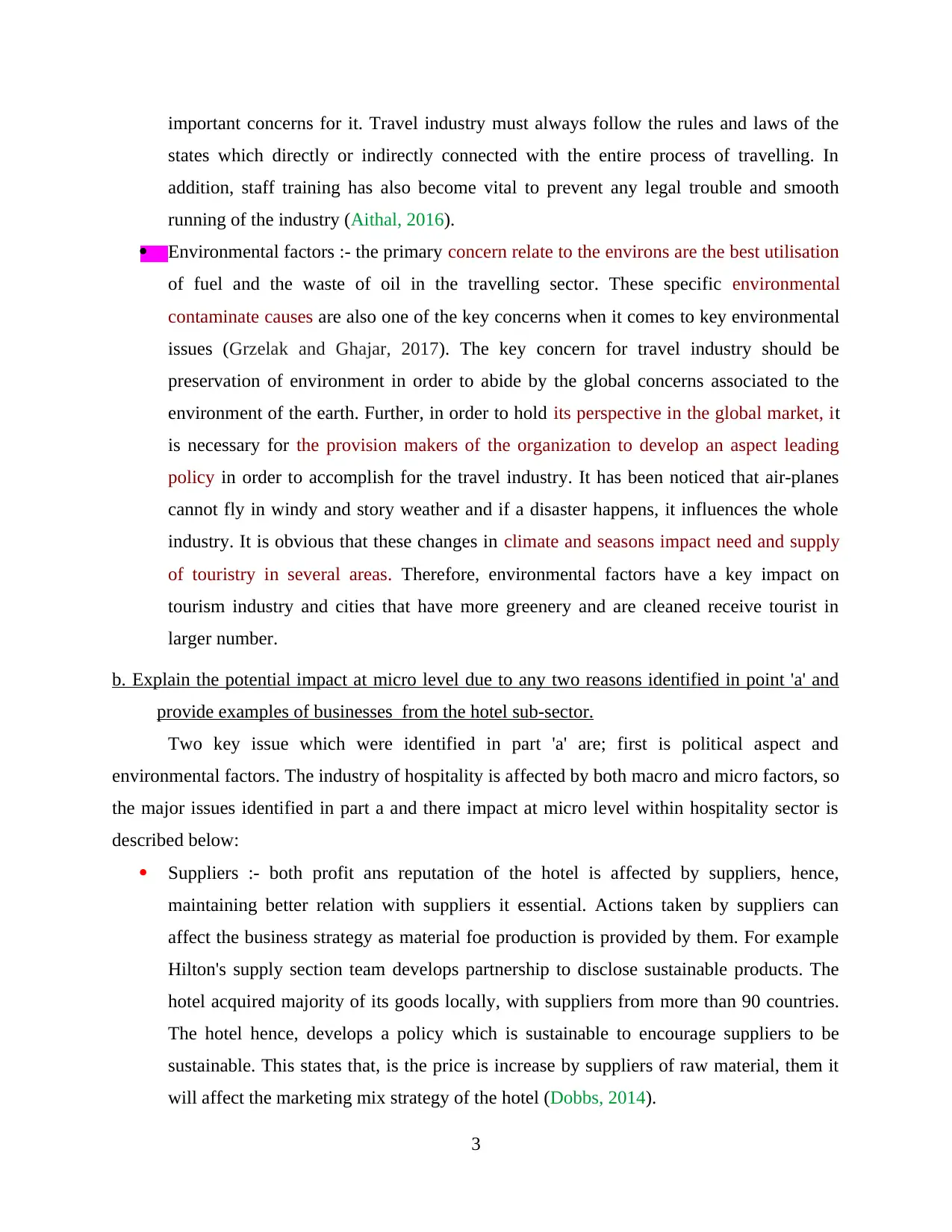
important concerns for it. Travel industry must always follow the rules and laws of the
states which directly or indirectly connected with the entire process of travelling. In
addition, staff training has also become vital to prevent any legal trouble and smooth
running of the industry (Aithal, 2016).
Environmental factors :- the primary concern relate to the environs are the best utilisation
of fuel and the waste of oil in the travelling sector. These specific environmental
contaminate causes are also one of the key concerns when it comes to key environmental
issues (Grzelak and Ghajar, 2017). The key concern for travel industry should be
preservation of environment in order to abide by the global concerns associated to the
environment of the earth. Further, in order to hold its perspective in the global market, it
is necessary for the provision makers of the organization to develop an aspect leading
policy in order to accomplish for the travel industry. It has been noticed that air-planes
cannot fly in windy and story weather and if a disaster happens, it influences the whole
industry. It is obvious that these changes in climate and seasons impact need and supply
of touristry in several areas. Therefore, environmental factors have a key impact on
tourism industry and cities that have more greenery and are cleaned receive tourist in
larger number.
b. Explain the potential impact at micro level due to any two reasons identified in point 'a' and
provide examples of businesses from the hotel sub-sector.
Two key issue which were identified in part 'a' are; first is political aspect and
environmental factors. The industry of hospitality is affected by both macro and micro factors, so
the major issues identified in part a and there impact at micro level within hospitality sector is
described below:
Suppliers :- both profit ans reputation of the hotel is affected by suppliers, hence,
maintaining better relation with suppliers it essential. Actions taken by suppliers can
affect the business strategy as material foe production is provided by them. For example
Hilton's supply section team develops partnership to disclose sustainable products. The
hotel acquired majority of its goods locally, with suppliers from more than 90 countries.
The hotel hence, develops a policy which is sustainable to encourage suppliers to be
sustainable. This states that, is the price is increase by suppliers of raw material, them it
will affect the marketing mix strategy of the hotel (Dobbs, 2014).
3
states which directly or indirectly connected with the entire process of travelling. In
addition, staff training has also become vital to prevent any legal trouble and smooth
running of the industry (Aithal, 2016).
Environmental factors :- the primary concern relate to the environs are the best utilisation
of fuel and the waste of oil in the travelling sector. These specific environmental
contaminate causes are also one of the key concerns when it comes to key environmental
issues (Grzelak and Ghajar, 2017). The key concern for travel industry should be
preservation of environment in order to abide by the global concerns associated to the
environment of the earth. Further, in order to hold its perspective in the global market, it
is necessary for the provision makers of the organization to develop an aspect leading
policy in order to accomplish for the travel industry. It has been noticed that air-planes
cannot fly in windy and story weather and if a disaster happens, it influences the whole
industry. It is obvious that these changes in climate and seasons impact need and supply
of touristry in several areas. Therefore, environmental factors have a key impact on
tourism industry and cities that have more greenery and are cleaned receive tourist in
larger number.
b. Explain the potential impact at micro level due to any two reasons identified in point 'a' and
provide examples of businesses from the hotel sub-sector.
Two key issue which were identified in part 'a' are; first is political aspect and
environmental factors. The industry of hospitality is affected by both macro and micro factors, so
the major issues identified in part a and there impact at micro level within hospitality sector is
described below:
Suppliers :- both profit ans reputation of the hotel is affected by suppliers, hence,
maintaining better relation with suppliers it essential. Actions taken by suppliers can
affect the business strategy as material foe production is provided by them. For example
Hilton's supply section team develops partnership to disclose sustainable products. The
hotel acquired majority of its goods locally, with suppliers from more than 90 countries.
The hotel hence, develops a policy which is sustainable to encourage suppliers to be
sustainable. This states that, is the price is increase by suppliers of raw material, them it
will affect the marketing mix strategy of the hotel (Dobbs, 2014).
3
⊘ This is a preview!⊘
Do you want full access?
Subscribe today to unlock all pages.

Trusted by 1+ million students worldwide
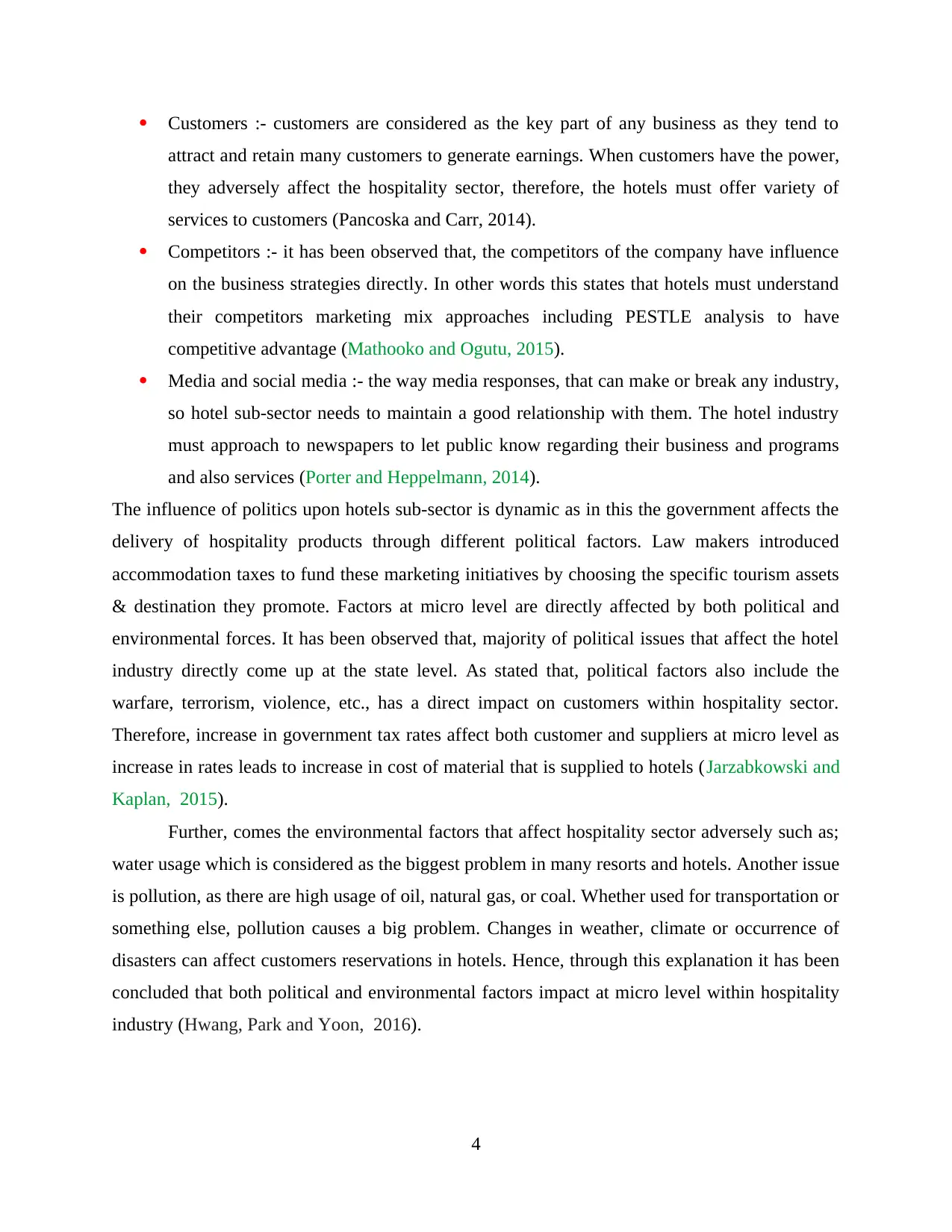
Customers :- customers are considered as the key part of any business as they tend to
attract and retain many customers to generate earnings. When customers have the power,
they adversely affect the hospitality sector, therefore, the hotels must offer variety of
services to customers (Pancoska and Carr, 2014).
Competitors :- it has been observed that, the competitors of the company have influence
on the business strategies directly. In other words this states that hotels must understand
their competitors marketing mix approaches including PESTLE analysis to have
competitive advantage (Mathooko and Ogutu, 2015).
Media and social media :- the way media responses, that can make or break any industry,
so hotel sub-sector needs to maintain a good relationship with them. The hotel industry
must approach to newspapers to let public know regarding their business and programs
and also services (Porter and Heppelmann, 2014).
The influence of politics upon hotels sub-sector is dynamic as in this the government affects the
delivery of hospitality products through different political factors. Law makers introduced
accommodation taxes to fund these marketing initiatives by choosing the specific tourism assets
& destination they promote. Factors at micro level are directly affected by both political and
environmental forces. It has been observed that, majority of political issues that affect the hotel
industry directly come up at the state level. As stated that, political factors also include the
warfare, terrorism, violence, etc., has a direct impact on customers within hospitality sector.
Therefore, increase in government tax rates affect both customer and suppliers at micro level as
increase in rates leads to increase in cost of material that is supplied to hotels (Jarzabkowski and
Kaplan, 2015).
Further, comes the environmental factors that affect hospitality sector adversely such as;
water usage which is considered as the biggest problem in many resorts and hotels. Another issue
is pollution, as there are high usage of oil, natural gas, or coal. Whether used for transportation or
something else, pollution causes a big problem. Changes in weather, climate or occurrence of
disasters can affect customers reservations in hotels. Hence, through this explanation it has been
concluded that both political and environmental factors impact at micro level within hospitality
industry (Hwang, Park and Yoon, 2016).
4
attract and retain many customers to generate earnings. When customers have the power,
they adversely affect the hospitality sector, therefore, the hotels must offer variety of
services to customers (Pancoska and Carr, 2014).
Competitors :- it has been observed that, the competitors of the company have influence
on the business strategies directly. In other words this states that hotels must understand
their competitors marketing mix approaches including PESTLE analysis to have
competitive advantage (Mathooko and Ogutu, 2015).
Media and social media :- the way media responses, that can make or break any industry,
so hotel sub-sector needs to maintain a good relationship with them. The hotel industry
must approach to newspapers to let public know regarding their business and programs
and also services (Porter and Heppelmann, 2014).
The influence of politics upon hotels sub-sector is dynamic as in this the government affects the
delivery of hospitality products through different political factors. Law makers introduced
accommodation taxes to fund these marketing initiatives by choosing the specific tourism assets
& destination they promote. Factors at micro level are directly affected by both political and
environmental forces. It has been observed that, majority of political issues that affect the hotel
industry directly come up at the state level. As stated that, political factors also include the
warfare, terrorism, violence, etc., has a direct impact on customers within hospitality sector.
Therefore, increase in government tax rates affect both customer and suppliers at micro level as
increase in rates leads to increase in cost of material that is supplied to hotels (Jarzabkowski and
Kaplan, 2015).
Further, comes the environmental factors that affect hospitality sector adversely such as;
water usage which is considered as the biggest problem in many resorts and hotels. Another issue
is pollution, as there are high usage of oil, natural gas, or coal. Whether used for transportation or
something else, pollution causes a big problem. Changes in weather, climate or occurrence of
disasters can affect customers reservations in hotels. Hence, through this explanation it has been
concluded that both political and environmental factors impact at micro level within hospitality
industry (Hwang, Park and Yoon, 2016).
4
Paraphrase This Document
Need a fresh take? Get an instant paraphrase of this document with our AI Paraphraser
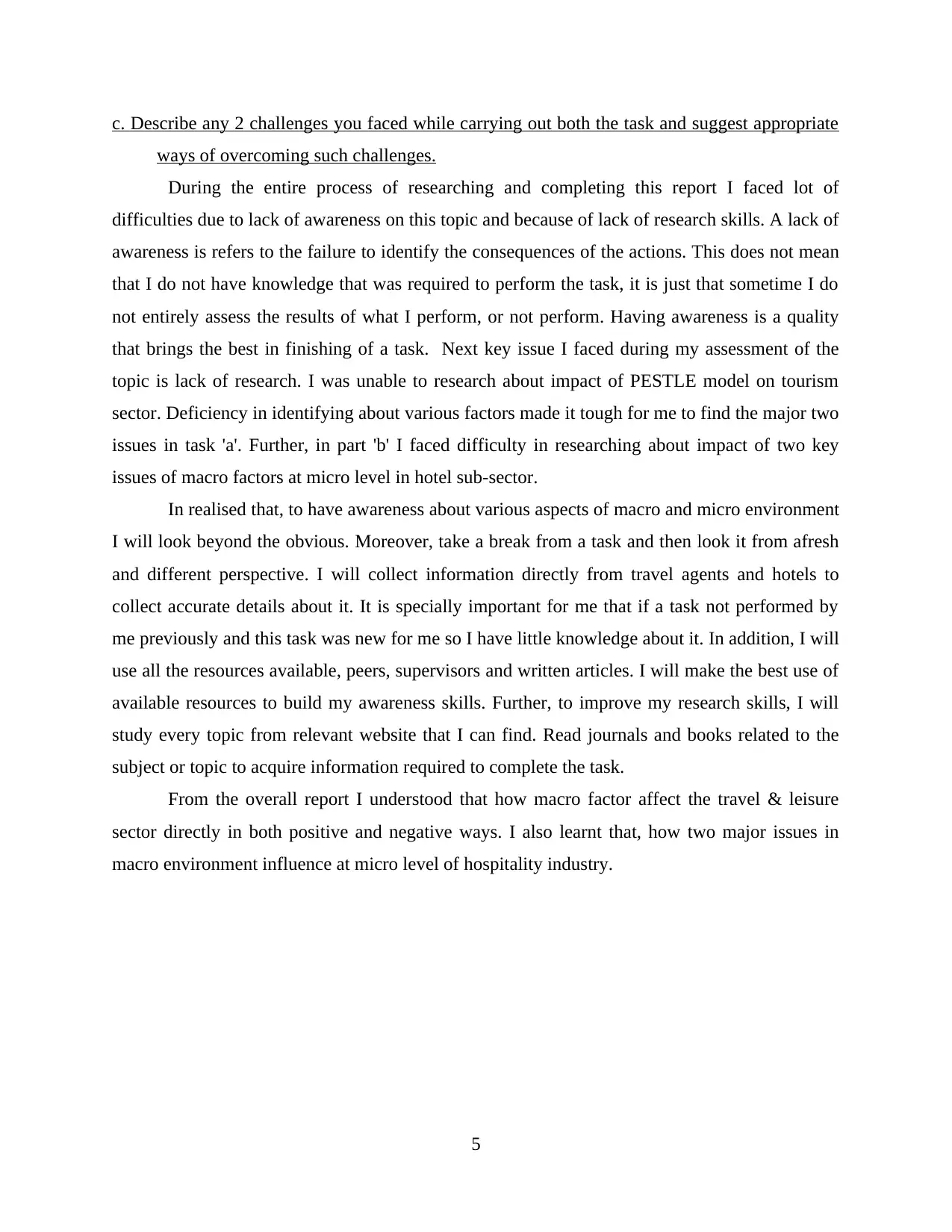
c. Describe any 2 challenges you faced while carrying out both the task and suggest appropriate
ways of overcoming such challenges.
During the entire process of researching and completing this report I faced lot of
difficulties due to lack of awareness on this topic and because of lack of research skills. A lack of
awareness is refers to the failure to identify the consequences of the actions. This does not mean
that I do not have knowledge that was required to perform the task, it is just that sometime I do
not entirely assess the results of what I perform, or not perform. Having awareness is a quality
that brings the best in finishing of a task. Next key issue I faced during my assessment of the
topic is lack of research. I was unable to research about impact of PESTLE model on tourism
sector. Deficiency in identifying about various factors made it tough for me to find the major two
issues in task 'a'. Further, in part 'b' I faced difficulty in researching about impact of two key
issues of macro factors at micro level in hotel sub-sector.
In realised that, to have awareness about various aspects of macro and micro environment
I will look beyond the obvious. Moreover, take a break from a task and then look it from afresh
and different perspective. I will collect information directly from travel agents and hotels to
collect accurate details about it. It is specially important for me that if a task not performed by
me previously and this task was new for me so I have little knowledge about it. In addition, I will
use all the resources available, peers, supervisors and written articles. I will make the best use of
available resources to build my awareness skills. Further, to improve my research skills, I will
study every topic from relevant website that I can find. Read journals and books related to the
subject or topic to acquire information required to complete the task.
From the overall report I understood that how macro factor affect the travel & leisure
sector directly in both positive and negative ways. I also learnt that, how two major issues in
macro environment influence at micro level of hospitality industry.
5
ways of overcoming such challenges.
During the entire process of researching and completing this report I faced lot of
difficulties due to lack of awareness on this topic and because of lack of research skills. A lack of
awareness is refers to the failure to identify the consequences of the actions. This does not mean
that I do not have knowledge that was required to perform the task, it is just that sometime I do
not entirely assess the results of what I perform, or not perform. Having awareness is a quality
that brings the best in finishing of a task. Next key issue I faced during my assessment of the
topic is lack of research. I was unable to research about impact of PESTLE model on tourism
sector. Deficiency in identifying about various factors made it tough for me to find the major two
issues in task 'a'. Further, in part 'b' I faced difficulty in researching about impact of two key
issues of macro factors at micro level in hotel sub-sector.
In realised that, to have awareness about various aspects of macro and micro environment
I will look beyond the obvious. Moreover, take a break from a task and then look it from afresh
and different perspective. I will collect information directly from travel agents and hotels to
collect accurate details about it. It is specially important for me that if a task not performed by
me previously and this task was new for me so I have little knowledge about it. In addition, I will
use all the resources available, peers, supervisors and written articles. I will make the best use of
available resources to build my awareness skills. Further, to improve my research skills, I will
study every topic from relevant website that I can find. Read journals and books related to the
subject or topic to acquire information required to complete the task.
From the overall report I understood that how macro factor affect the travel & leisure
sector directly in both positive and negative ways. I also learnt that, how two major issues in
macro environment influence at micro level of hospitality industry.
5
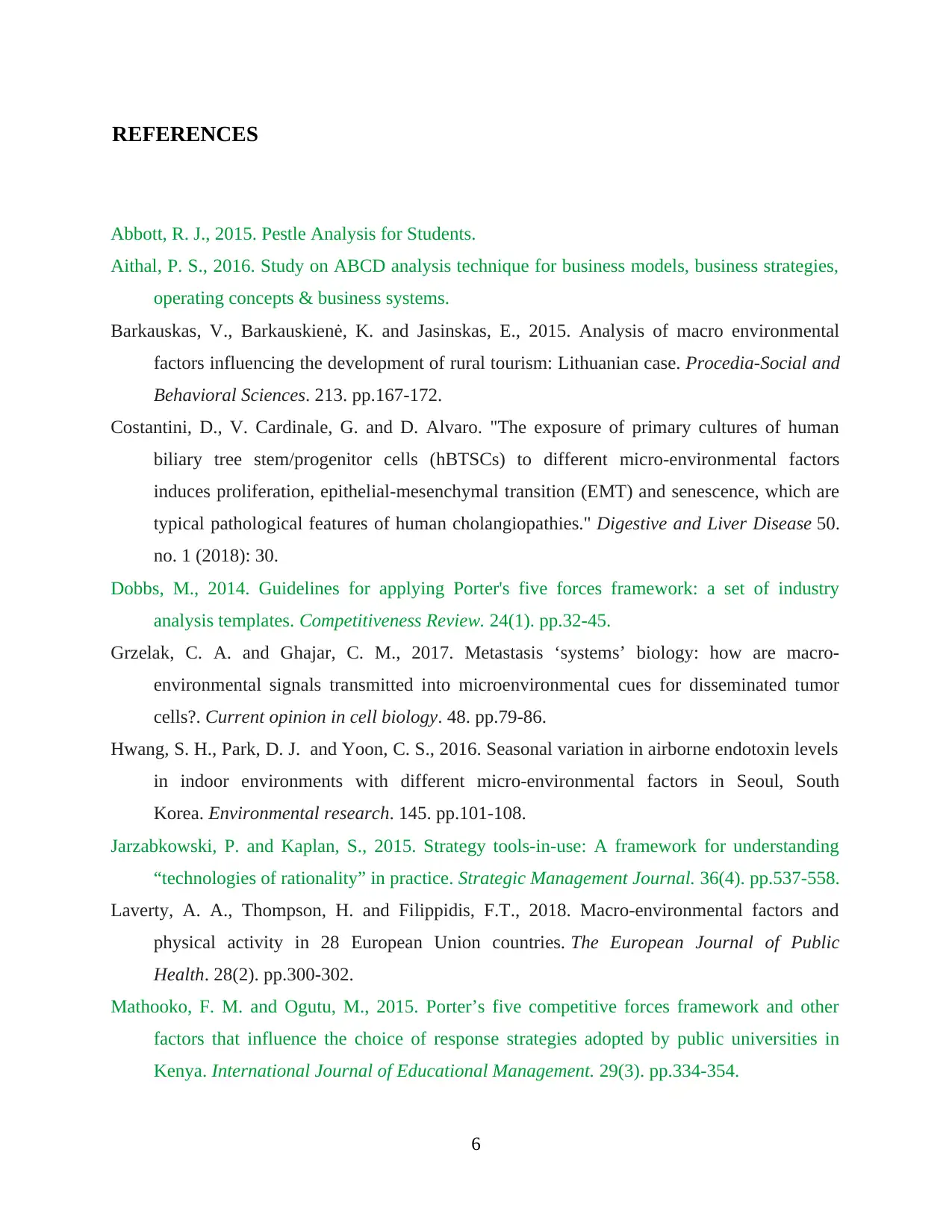
REFERENCES
Abbott, R. J., 2015. Pestle Analysis for Students.
Aithal, P. S., 2016. Study on ABCD analysis technique for business models, business strategies,
operating concepts & business systems.
Barkauskas, V., Barkauskienė, K. and Jasinskas, E., 2015. Analysis of macro environmental
factors influencing the development of rural tourism: Lithuanian case. Procedia-Social and
Behavioral Sciences. 213. pp.167-172.
Costantini, D., V. Cardinale, G. and D. Alvaro. "The exposure of primary cultures of human
biliary tree stem/progenitor cells (hBTSCs) to different micro-environmental factors
induces proliferation, epithelial-mesenchymal transition (EMT) and senescence, which are
typical pathological features of human cholangiopathies." Digestive and Liver Disease 50.
no. 1 (2018): 30.
Dobbs, M., 2014. Guidelines for applying Porter's five forces framework: a set of industry
analysis templates. Competitiveness Review. 24(1). pp.32-45.
Grzelak, C. A. and Ghajar, C. M., 2017. Metastasis ‘systems’ biology: how are macro-
environmental signals transmitted into microenvironmental cues for disseminated tumor
cells?. Current opinion in cell biology. 48. pp.79-86.
Hwang, S. H., Park, D. J. and Yoon, C. S., 2016. Seasonal variation in airborne endotoxin levels
in indoor environments with different micro-environmental factors in Seoul, South
Korea. Environmental research. 145. pp.101-108.
Jarzabkowski, P. and Kaplan, S., 2015. Strategy tools‐in‐use: A framework for understanding
“technologies of rationality” in practice. Strategic Management Journal. 36(4). pp.537-558.
Laverty, A. A., Thompson, H. and Filippidis, F.T., 2018. Macro-environmental factors and
physical activity in 28 European Union countries. The European Journal of Public
Health. 28(2). pp.300-302.
Mathooko, F. M. and Ogutu, M., 2015. Porter’s five competitive forces framework and other
factors that influence the choice of response strategies adopted by public universities in
Kenya. International Journal of Educational Management. 29(3). pp.334-354.
6
Abbott, R. J., 2015. Pestle Analysis for Students.
Aithal, P. S., 2016. Study on ABCD analysis technique for business models, business strategies,
operating concepts & business systems.
Barkauskas, V., Barkauskienė, K. and Jasinskas, E., 2015. Analysis of macro environmental
factors influencing the development of rural tourism: Lithuanian case. Procedia-Social and
Behavioral Sciences. 213. pp.167-172.
Costantini, D., V. Cardinale, G. and D. Alvaro. "The exposure of primary cultures of human
biliary tree stem/progenitor cells (hBTSCs) to different micro-environmental factors
induces proliferation, epithelial-mesenchymal transition (EMT) and senescence, which are
typical pathological features of human cholangiopathies." Digestive and Liver Disease 50.
no. 1 (2018): 30.
Dobbs, M., 2014. Guidelines for applying Porter's five forces framework: a set of industry
analysis templates. Competitiveness Review. 24(1). pp.32-45.
Grzelak, C. A. and Ghajar, C. M., 2017. Metastasis ‘systems’ biology: how are macro-
environmental signals transmitted into microenvironmental cues for disseminated tumor
cells?. Current opinion in cell biology. 48. pp.79-86.
Hwang, S. H., Park, D. J. and Yoon, C. S., 2016. Seasonal variation in airborne endotoxin levels
in indoor environments with different micro-environmental factors in Seoul, South
Korea. Environmental research. 145. pp.101-108.
Jarzabkowski, P. and Kaplan, S., 2015. Strategy tools‐in‐use: A framework for understanding
“technologies of rationality” in practice. Strategic Management Journal. 36(4). pp.537-558.
Laverty, A. A., Thompson, H. and Filippidis, F.T., 2018. Macro-environmental factors and
physical activity in 28 European Union countries. The European Journal of Public
Health. 28(2). pp.300-302.
Mathooko, F. M. and Ogutu, M., 2015. Porter’s five competitive forces framework and other
factors that influence the choice of response strategies adopted by public universities in
Kenya. International Journal of Educational Management. 29(3). pp.334-354.
6
⊘ This is a preview!⊘
Do you want full access?
Subscribe today to unlock all pages.

Trusted by 1+ million students worldwide
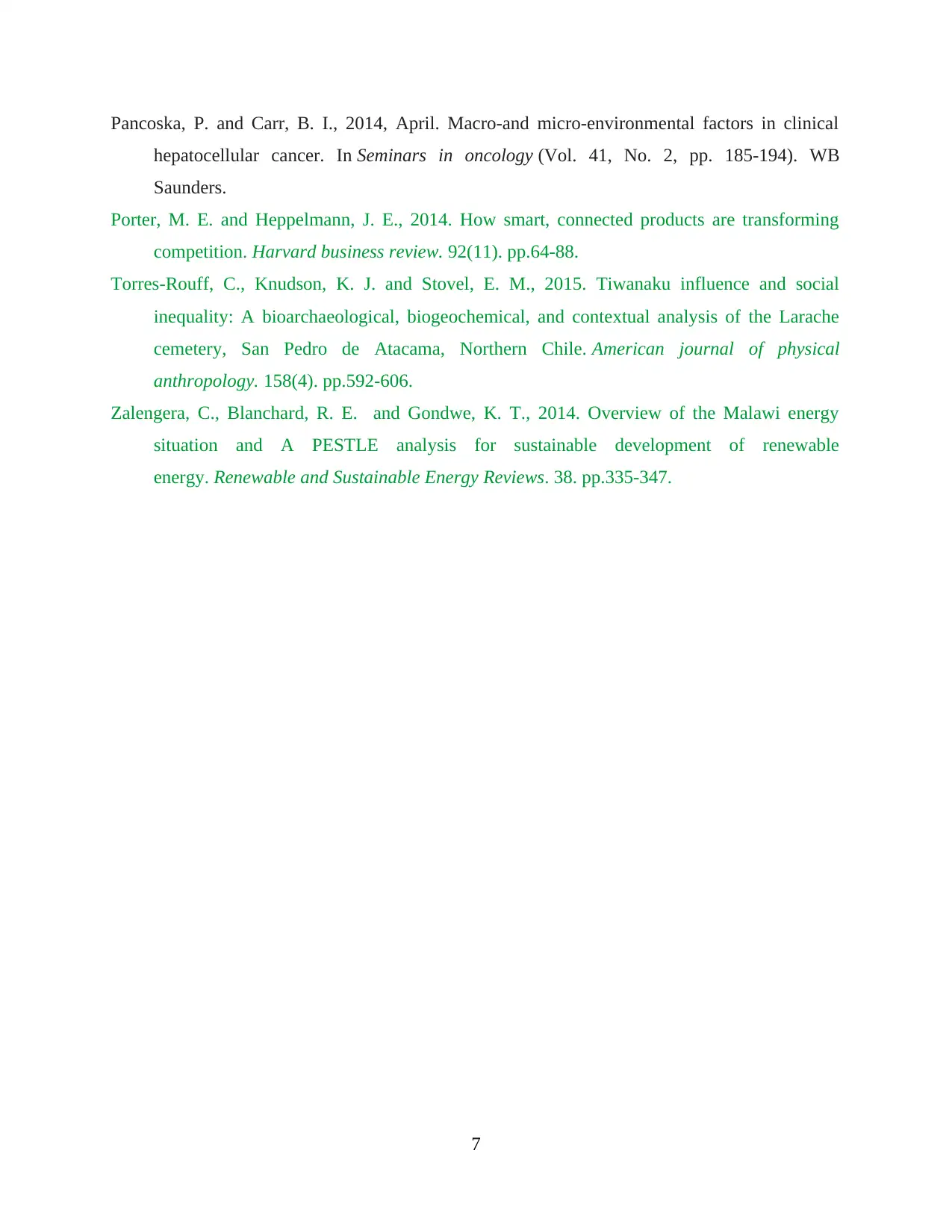
Pancoska, P. and Carr, B. I., 2014, April. Macro-and micro-environmental factors in clinical
hepatocellular cancer. In Seminars in oncology (Vol. 41, No. 2, pp. 185-194). WB
Saunders.
Porter, M. E. and Heppelmann, J. E., 2014. How smart, connected products are transforming
competition. Harvard business review. 92(11). pp.64-88.
Torres‐Rouff, C., Knudson, K. J. and Stovel, E. M., 2015. Tiwanaku influence and social
inequality: A bioarchaeological, biogeochemical, and contextual analysis of the Larache
cemetery, San Pedro de Atacama, Northern Chile. American journal of physical
anthropology. 158(4). pp.592-606.
Zalengera, C., Blanchard, R. E. and Gondwe, K. T., 2014. Overview of the Malawi energy
situation and A PESTLE analysis for sustainable development of renewable
energy. Renewable and Sustainable Energy Reviews. 38. pp.335-347.
7
hepatocellular cancer. In Seminars in oncology (Vol. 41, No. 2, pp. 185-194). WB
Saunders.
Porter, M. E. and Heppelmann, J. E., 2014. How smart, connected products are transforming
competition. Harvard business review. 92(11). pp.64-88.
Torres‐Rouff, C., Knudson, K. J. and Stovel, E. M., 2015. Tiwanaku influence and social
inequality: A bioarchaeological, biogeochemical, and contextual analysis of the Larache
cemetery, San Pedro de Atacama, Northern Chile. American journal of physical
anthropology. 158(4). pp.592-606.
Zalengera, C., Blanchard, R. E. and Gondwe, K. T., 2014. Overview of the Malawi energy
situation and A PESTLE analysis for sustainable development of renewable
energy. Renewable and Sustainable Energy Reviews. 38. pp.335-347.
7
1 out of 10
Related Documents
Your All-in-One AI-Powered Toolkit for Academic Success.
+13062052269
info@desklib.com
Available 24*7 on WhatsApp / Email
![[object Object]](/_next/static/media/star-bottom.7253800d.svg)
Unlock your academic potential
Copyright © 2020–2025 A2Z Services. All Rights Reserved. Developed and managed by ZUCOL.





